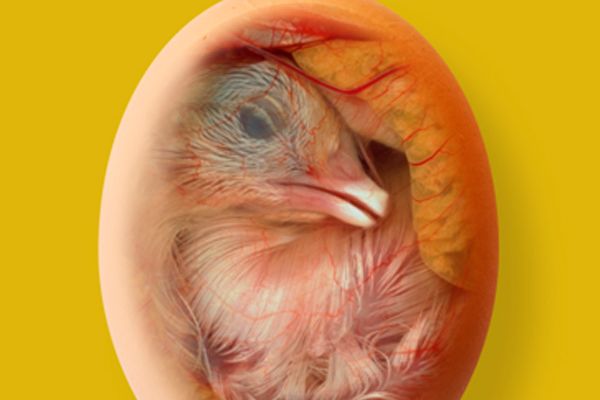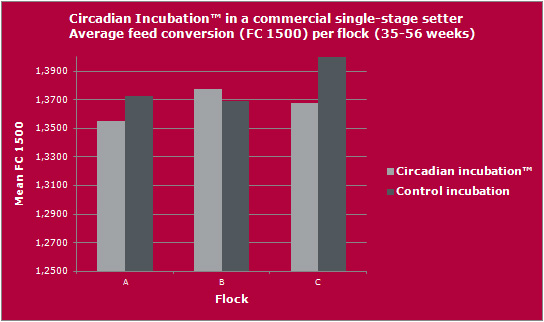Circadian Incubation™: a new feature of singlestage incubation
Tags: Incubation | Whitepaper
, 11 June 2012

We know that a combination of genetic and environmental factors shape the embryonic body as well as the formation and maturation of functional tissues and organs. While the genetic make-up of the chicken embryo contains basic instructions for the development and formation of the body, developmental fine-tuning occurs through the interaction of environmental factors and the expression of genes.
In chicken, embryonic differentiation starts during egg formation and continues in the incubator, after a period of cooling and storage of the eggs. At the end of the second week of incubation, the embryo has almost reached its final size and shape. In this phase of development, differential gene expression guides the maturation of physiological control circuits. The maturing embryo is sensitive to environmental stimuli such that physiological control systems can be trained or ‘adapted’, to cope with stressful environments for the long term.
It has been proven that incubation temperature influences the expression of genes involved in the maturation of body temperature control. Chronic, continuous temperatures that are too high or too low negatively affect maturation. Conversely, short, daily temperature stimuli (Circadian Incubation™) produce long-lasting effects by training or ‘imprinting’ the thermoregulatory system – and it has been shown that training the thermoregulatory system during the maturation phase reduces the basic metabolic needs of the growing chicken. Temperature training induces a lowered body temperature at the thermoneutral zone - and thereby the amount of nutrient required to maintain the chick’s body temperature.
Consequently, short daily temperature stimuli have a positive effect on economical parameters, such as hatchability, robustness, final bodyweight and feed conversion ratios. Temperature stimuli applied during the embryonic maturation phase also have a long lasting effect on resistance to heat stress in adult birds. However long lasting adaptation by Circadian Incubation™ only occurs if temperature stimuli are applied during critical, sensitive phases of development. In the chicken, this is during the final days of incubation, and further investigations are being carried out to define the optimum intensity and length of temperature stimulations for different egg types.
Circadian Incubation™ has already demonstrated positive affects on hatchability and feed conversion rates in commercial hatcheries and broiler farms, although interaction with breeder farms limits routine application. Figure 1 shows the variability in feed conversion rates in chicks hatched from eggs produced by different breeder farms. Future investigations will help to further understand the variable responses found in commercial practice.
Advice
- Optimize hatchery results using Circadian iIncubation™ if single stage stage incubation practice is routine in your hatchery.
- Ensure accurate climate control in setters, to promote optimised temperature uniformity and sufficient cooling capacity that the incubation temperature can be reduced quickly and uniformly at the end of each temperature stimulus.
- Start Circadian Incubation™ on day 16.5 (2 hr at 100 °F set point) and continue through days 17.5 and 18.5 (1 hr at 100 °F) of incubation.
- Evaluate the results of Circadian Incubation™ in the hatchery and on the farm for each batch of eggs separately.
- Find the optimum length of temperature stimulation by undertaking trials on different batches of eggs of differing quality.
- Evaluate hatchability, chick quality and farm results after each trial of Circadian Incubation™.

Figure 1. Average feed conversion rates (FC 1500) of broilers from three different breeder flocks. For each flock, four different Circadian Incubation™ cycles were performed in a large scale commercial single stage incubator. For each flock, experiments were performed at flock ages 35, 42, 48 and 56 respectively. For both Circadian™ and Control incubation, the growth and feed consumption of 4560 chicks were followed for 35 days.
Written by Dr. Marleen Boerjan
We welcome your feedback on this article - and if you require any additional information, please don't hesitate to contact Pas Reform Academy.